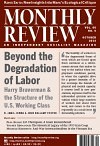Political Economy
Not since the Great Depression of the 1930s has it been so apparent that the core capitalist economies are experiencing secular stagnation, characterized by slow growth, rising unemployment and underemployment, and idle productive capacity. Consequently, mainstream economics is finally beginning to recognize the economic stagnation tendency that has long been a focus in these pages, although it has yet to develop a coherent analysis of the phenomenon. Accompanying the long-term decline in the growth trend has been an extraordinary increase in economic inequality, which one of us labeled “The Great Inequality,” and which has recently been dramatized by the publication of French economist Thomas Piketty’s Capital in the Twenty-First Century. Taken together, these two realities of deepening stagnation and growing inequality have created a severe crisis for orthodox (or neoclassical) economics. | more…

Secular stagnation (or the trend towards long-term slow growth and continuing high unemployment/underemployment) has become a big issue in the mature economies since 2013, when former U.S. Treasury Secretary Larry Summers raised the question at an IMF economic forum. Compilations of work on the subject can now be found on the Internet, such as the one by economists Coen Teulings and Richard Baldwin; which however leaves out all contributions by heterodox economists. Teulings and Baldwin credit Summers with having “resurrected” the secular stagnation issue. But is this true? Only in the sense that he reintroduced it to mainstream neoclassical economics. It has long been a topic on the left, and particularly in Monthly Review, where editor Paul Sweezy explicitly drew attention to the “secular stagnation” question more than forty years ago—with MR tracking the stagnation trend month by month in the four decades that followed.… Isn’t it about time…that orthodox economists, Summers included, began to acknowledge the enormous work done on this topic on the left over decades, and indeed the greater complexity and historicity of the analysis to be found there—not only in MR but within heterodox economics more generally? Such an admission might even do orthodox economists some good. | more…
Braverman and the Structure of the U.S. Working Class
Harry Braverman’s Labor and Monopoly Capital, first published forty years ago in 1974, was unquestionably the work that, in the words of historian Bryan Palmer, “literally christened the emerging field of labor process studies.” In the four decades since its appearance Braverman’s book has continued to play a central role in debates on workers’ struggles within industry, remaining indispensable to all attempts at in-depth critique in this area.… This continuing relevance of Braverman’s analysis has to do with the fact that his overall vision of the transformations taking place in modern work relations was much wider than has usually been recognized. Viewed from a wide camera angle, his work sought to capture the complex relation between the labor process on the one hand, and the changing structure and composition of the working class and its reserve armies on the other. This broad view allowed him to perceive how the changes in the labor process were integrally connected to the emergence of whole new spheres of production, the decomposition and recomposition of the working class in various sectors, and the development of new structural contradictions. | more…
It is not by chance that the very title of this contribution links the return of fascism on the political scene with the crisis of contemporary capitalism. Fascism is not synonymous with an authoritarian police regime that rejects the uncertainties of parliamentary electoral democracy. Fascism is a particular political response to the challenges with which the management of capitalist society may be confronted in specific circumstances. | more…
The current stage of capitalism is characterized by the increased power of finance capital. How to understand the economics of this shift and its political implications is now central for both the left and the larger society. There can be little doubt that a signature development of our time is the growth of finance and monopoly power. | more…
Fred Block responds to the Notes from the Editors, June 2014, which drew attention to Block’s recently published article, “Varieties of What?: Should We Still Be Using the Concept of Capitalism?” The editors reply. | more…
Monopoly-Finance Capital, the Military-Industrial Complex, and the Digital Age
The United States came out of the Second World War as the hegemonic power in the world economy. The war had lifted the U.S. economy out of the Great Depression by providing the needed effective demand in the form of endless orders for armaments and troops. Real output rose by 65 percent between 1940 and 1944, and industrial production jumped by 90 percent. At the immediate end of the war, due to the destruction of the European and Japanese economies, the United States accounted for over 60 percent of world manufacturing output. The very palpable fear at the top of society as the war came to a close was that of a reversion to the pre-war situation in which domestic demand would be insufficient to absorb the enormous and growing potential economic surplus generated by the production system, thereby leading to a renewed condition of economic stagnation and depression.… Postwar planners in industry and government moved quickly to stabilize the system through the massive promotion of a sales effort in the form of a corporate marketing revolution based in Madison Avenue, and through the creation of a permanent warfare state, dedicated to the imperial control of world markets and to fighting the Cold War, with its headquarters in the Pentagon. The sales effort and the military-industrial complex constituted the two main surplus-absorption mechanisms (beyond capitalist consumption and investment) in the U.S. economy in the first quarter-century after the Second World War. | more…
The Corporate Security Campaign That Would Not Die
The government-corporate surveillance complex is consolidating. What has been a confidential but informal collaboration now seeks to legalize its special status.… July 9, 2012, was a scorcher in Washington, DC, with afternoon temperatures over 100 degrees, when an audience of about fifty think-tankers convened in a third-floor briefing room of the Senate’s Russell Office Building on Capitol Hill. Then-Senator John Kyl sponsored the show, although he did not appear in person. He had invited the American Center for Democracy (ACD) and the Economic Warfare Institute (EWI) to explore the topic of “Economic Warfare Subversions: Anticipating the Threat.” | more…
How Military Contractors Reap Billions from U.S. Military Bases Overseas
“You whore it out to a contractor,” Major Tim Elliott said bluntly. It was April 2012, and I was at a swank hotel in downtown London attending “Forward Operating Bases 2012,” a conference for contractors building, supplying, and maintaining military bases around the world. IPQC, the private company running the conference, promised the conference would “bring together buyers and suppliers in one location” and “be an excellent platform to initiate new business relationships” through “face-to-face contact that overcrowded trade shows cannot deliver.” Companies sending representatives included major contractors like General Dynamics and the food services company Supreme Group, which has won billions in Afghan war contracts, as well as smaller companies like QinetiQ, which produces acoustic sensors and other monitoring devices used on bases. “We’re profiteers,” one contractor representative said to the audience in passing, with only a touch of irony. | more…

Samir Amin’s Review of the Month in this issue, “Popular Movements Toward Socialism,” offers a masterful analysis of struggles all over the world in the era of what he calls “generalized-monopoly capitalism.” The most important theoretical innovation in his article, in our opinion, is his attempt to bring together a variety of global struggles under the rubric of the “movement toward socialism,” borrowing the terminology from the current practice of a number of South American parties: in Bolivia, Chile, and elsewhere. Movements that fall under this mantle, Amin suggests, may include those that seek to transcend capitalism, as well as others for which the object is more ambiguously a radical upending of labor-capital relations. | more…
The Nature of the Contradiction
More than six years after the beginning of the Great Recession in the United States, and nearly five years since it was officially declared over in this country, the core economies of the capitalist world system remain crisis-ridden. The jobs lost in the downturn in the United States have not yet been fully recovered and the economy remains sluggish. In Europe the crisis has hardly abated at all and a number of the peripheral European Union countries are in what can only be called a depression—especially Greece, Spain, and Portugal. The last member of the triad of advanced capitalist centers, Japan, has gone through what have been called two “lost decades” of slow growth and deflation and is attempting once again to jump-start the economy through a combination of devaluation of the yen and deficit spending. | more…
Many Australians view themselves as living in a “lucky country” because it has an abundance of mineral resources. James Goodman and David Worth, however, maintain that the mining boom has been a “curse” in disguise. It has sharpened socioeconomic and community divisions, contributed to political conflict, and resulted in “ecological mal-development” with serious environmental consequences. This applies to coal in that it not only contributes to air and water pollution, but is also a major source of carbon dioxide emissions and thus a major contributor to climate change. | more…

